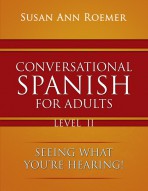People learn their languages by hearing words and then understanding what they mean. A child learns words, strings them together in phrases and is later corrected by his or her parents. Imagine if a 4-year-old in saying a sentence were forced to say the complete conjugation of the verb before going on to the next phrase! Yet many people think that to learn a new language they need to learn all the conjugations before they continue.
This method is in essence a “mapping of sounds.” The students are taught a phrase, what it means in English and what the sounds look like through a phonetic transcription that is unique to this method. Spanish language learners may practice the sounds without the need of an instructor being present. The advantage is clear:it is one thing to hear the sounds and repeat the words; it’s quite another thing to have a visual image of what the sounds look like. Recent research confirms what many have long suspected – most people are a combination of visual and auditory learners. It only makes sense that a teaching approach should be directed at both modalities in addition to some kinesthetic activities to reinforce the learning. The students will be able to take what was spoken in the classroom and easily reinforce it at home through additional practice.
 Updating...
Updating... 
